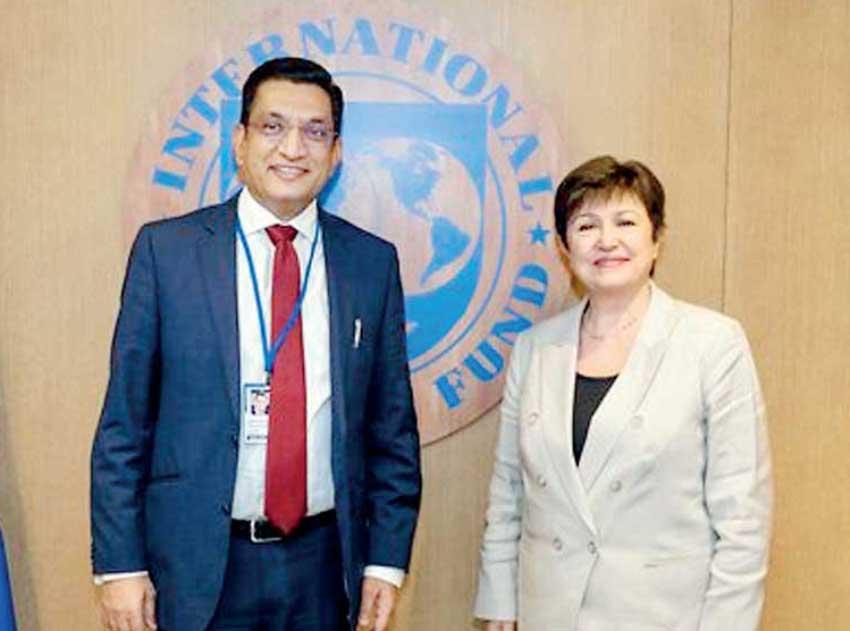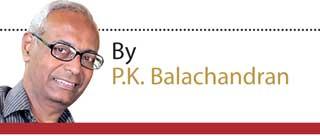A Brief Colonial History Of Ceylon(SriLanka)
Sri Lanka: One Island Two Nations
A Brief Colonial History Of Ceylon(SriLanka)
Sri Lanka: One Island Two Nations
(Full Story)
Search This Blog
Back to 500BC.
==========================
Thiranjala Weerasinghe sj.- One Island Two Nations
?????????????????????????????????????????????????Saturday, April 30, 2022
Drastic changes in economic, political and legal policies are needed

Ali Sabry with IMF chief Kristalina Georgieva
30 April 2022
Sri Lanka is negotiating with the IMF for help to overcome the present forex crisis. But the IMF’s prescriptions could be challenging. It has already made it clear that Sri Lanka has to begin setting its house in order before aid can flow. The IMF has also said that Sri Lanka is not eligible for the emergency Rapid Financing Instrument (RFI), though India has urged it to make the Sri Lankan case an exception.
The IMF’s representative in Sri Lanka, Masahiro Nozaki, told Reuters that since Sri Lanka’s external debt is unsustainable, it has to take steps to ensure debt sustainability. It has to restructure debts owed to foreign entities, including China. The IMF is also expected to ask Sri Lanka to adopt prudence and austerity to prevent wastage.
To properly assess a country’s debt sustainability, the IMF takes into account all types of debt that pose a risk to a country’s public finances. “If a loss-making state-owned enterprise is not able to service its debt, the burden ultimately falls on the central government, because such debt is publicly guaranteed, leading to an unexpected weakening in a country’s debt sustainability. Defaults can cause borrowing countries to lose market access and suffer higher borrowing costs, in addition to harming growth and investment,” warns Dalia Hakura warns of the IMF in a note. 
A country’s debt-carrying capacity depends on several factors such as the quality of institutions, debt management capacity, government policies, macro-economic fundamentals, besides global economic environment, she says.
In a paper in http://www.managing-debt-blueprint-for-sri-lanka.co.uk// on the Sri Lankan case, an UK- based Sri Lankan, Aravind Korala, argues that going to the IMF for relief can only give temporary relief. The IMF can at best ask creditors to accept a “haircut” or write off a part of the debt. Unless Sri Lanka makes structural, ideological and policy changes, it will keep going to the IMF periodically for temporary palliatives, he warns.
Korala urges Sri Lankans to shed some of their prejudices and the entrenched fear of foreign domination, and reform their systems. If they do so, the island’s considerable resources could be greatly enhanced to enable it to borrow without anxiety about repayment. Sri Lanka has an external debt of about US$ 51 billion. More than US$ 6 billion of that has to be repaid in 2022. This debt, by itself, is not the problem. The issue is Sri Lanka’s inability to repay the debt on account of a lack of resources, he says.
All countries borrow for economic development. The US has a US$ 22 trillion external debt. The UK has five times as much external debt as Sri Lanka, Korala points out. But the US and UK have no debt servicing problem because they are in a position to pay back, while Sri Lanka is not. Sri Lanka is not poor, he says. According to the Credit Suisse and McKinsey Global Institute’s global wealth report, Sri Lanka’s net wealth is US$ 351 billion after the current external debt is deducted.
Sri Lanka’s debt to assets ratio is 13% compared with the UK’s 62%. How then is the UK not in hotter water and Sri Lanka is, Korala asks. The reason is that UK’s debt is “secured debt” while Sri Lanka’s debt is “unsecured debt.” When foreign parties lend to a UK institution, that debt is secured on assets owned by the borrowing UK institution. If the UK borrower is unable to repay the debt, the lender will seize that asset, sell it and recover the debt. And if there is a dispute between the borrower and the lender, the UK courts would resolve the matter impartially and efficiently, Korala says.
Therefore, for debt sustainability, asset creation is very important. Modern states facilitate asset creation by both domestic and foreign investors. The Chinese have enormous assets in the US, which are helping the latter grow. Americans don’t feel insecure about Chinese investment despite political animosity. But Sri Lanka does not allow foreign ownership of assets fearing loss of sovereignty.
“Sri Lanka can change the situation overnight by changing laws to guarantee foreigners’ ownership of Sri Lankan assets, and by guaranteeing that foreign debt will always be serviced and repaid – by law” Korala submits.
Lenders are not in short supply as they make money by lending. They are not even in a hurry to recover their money as long as they get the interest. But they should be assured that the borrower continues to pay interest, that there is no risk of default, and that the courts will help in the recovery, he says.
To increase national wealth that will make creditors lend confidently, Sri Lanka should enter the world economy by inviting foreign investors, allow them to acquire assets for wealth creation, and industrialize to increase exports and earn foreign exchange. Sri Lanka should join the global value chain so that production, export and employment increase. Assets can be sold to make money as indeed the government plans to do. When the Colombo Port City is fully built, the total amount of wealth created by it will probably exceed US$100 billion, if ownership rights are granted, Korala predicts.
Sri Lanka is in the red because it imports more than it exports. Efforts should be made to increase exports by a diversification of products and the market for export. Government must not prop up loss making companies. It should allow companies to sink or swim, while encouraging technical innovation, R and D, and increased productivity. Industries and sectors in which Sri Lanka has a natural advantage should be encouraged for investment and trade rather than try and replicate what other countries can do better.
Sri Lanka must also borrow prudently and not go in for expensive short term debt as it has been doing from 2014. Writing in The Diplomat, economist Umesh Moramudali says that in the early 1990s, the majority of Sri Lanka’s foreign debt consisted of concessionary loans, most of which were provided by multilateral and bilateral development agencies such as the World Bank, ADB, and JAICA. These loans had a long payback period, a considerable grace period, and were subjected to a low-interest rate. Most of these concessionary loan repayments were spread over 25 to 40 years with a low interest rate of around 1 percent or less.
However, following Sri Lanka’s upgrade to a middle-income country, its ability to access concessionary loans provided by multilateral agencies and bilateral donors declined. Therefore, Sri Lanka had to look for alternative foreign financing sources. But due to the heavy reliance on International Sovereign Bonds (ISBs), Sri Lanka’s foreign debt composition changed completely. “By 2019, 56% of the foreign loans were commercial borrowings, most of which were ISBs,” Moramudali says. ISBs have a payback period of 5-10 years with an annual interest rate above 6% to be paid biannually. On top of that, there are principal payments. The total borrowed amount of an ISB is settled at the bond maturity date, all at once, rather than being distributed over the years through annual repayments, he adds.
Sri Lanka will have to cut down on expensive commercial loans and borrow from less expensive sources. But the ideal solution is to canvass internationally for investments and not loans, as President Gotabaya Rajapaksa has been advocating ever since he came to power in 2019. Combined with other changes suggested by Korala, Sri Lanka may be able to avoid falling into a debt trap again.
